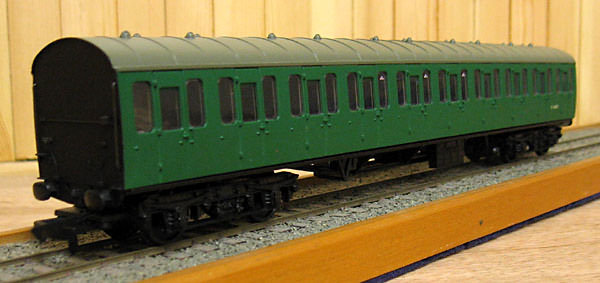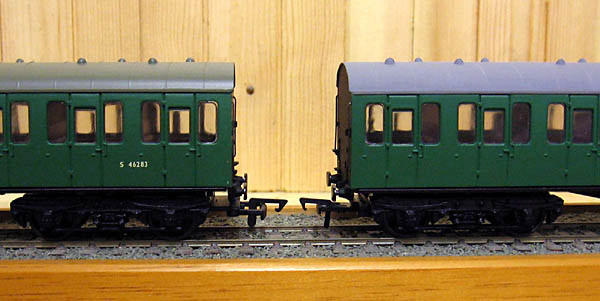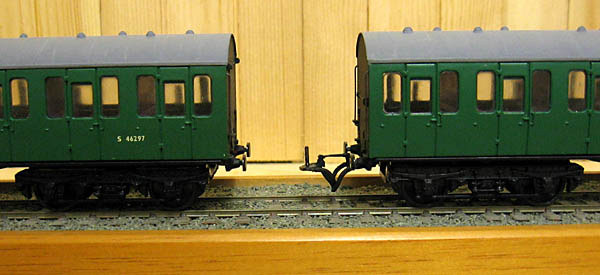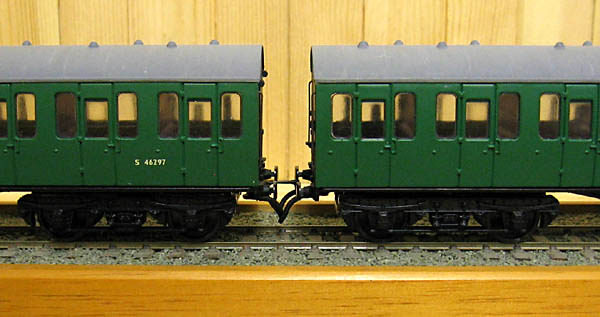Upgrading Replica Mk1 suburban coaches
Improvements by Colin Watts
| The Replica MkI suburban coaches are a welcome addition to the
model market and are nice models as they tumble out of the box. However, they
do benefit from some minor upgrading.
Replica's first release was 3-set 154 as used on the Exmouth Branch with, at the time of writing, sets 152 and 153 to follow. In addition four loose seconds (S) were also produced. Following transfer of the Exmouth Branch to the Western, two of these seconds were transferred into 7-set 904 for use on the Oxted line. The coaches dismantle fairly easily as the bogies are a simple push fit and the bodies are held on by three lugs on each side enabling them to be carefully prised apart. Unfortunately the interiors are firmly glued onto the underframes and would have benefited from fixing with soft removable glue. The first step is to paint the seating and fit carriage prints to the backs of the compartments.
Whilst the interior is drying the second step is to scrape down the oversized ridge detail on the roof. Like the Bachmann vehicles these coaches are modelled with prominent ridges. However, in reality these ridges are actually the welded seams in the roof and in modelling terms are imperceptible in height, although visually prominent. Careful use of a chisel blade to gently scrape along the ridges rapidly reduces them to a barely perceptible line. When painted these yield a close approximation to the seam lines. The coaches are unusually modelled with retracted oval buffers and unless the modeller wishes to change them, they can be left to aid the close coupling of the coaches. Fitted with Jackson wheels from new, the Replica bogies come with a massive coupling fixing plate, which extends out from underneath the coach end. A tension-lock coupling is screw fitted to this plate. This coupling fixing plate can be cut short (not right off) and the residual used to affix a long-type Bachmann mini-coupling. The actual position of the mini-coupling needs to be considered with respect to the radii of the trackwork upon which the coaches are to be used.
Within the three coach sets (B-C-B) Bill Bedford couplings can be used although other coupling types are available. The Bill Bedford couplings come in various lengths and give the appearance of a screw coupling under tension plus the brake /steam heating pipes swinging below. These couplings are easily fitted to the underframes although some modification to the buffer beam is required to enable the coupling to move freely. The coupling fixing plate on the adjacent bogie is simply removed and discarded. Once fitted, these couplings considerably enhance the coaches although once again care is required with respect to designing for the radii of the trackwork upon which the coaches are to be used.
The all-seconds (S) can be coupled in pairs with Bill Bedford couplings on the inner ends. By turning the coaches outward this arrangement can still permit the prototypical substitution of a pair of seconds into the three sets to form a five-car B-C-S-S-B, although it most be noted that most photographs illustrate the strengthened sets as B-S-C-S-B or most commonly as S-B-C-B-S. However, by purchasing additional bogies (and fitting long-type Bachmann mini-couplings thereon) the Bill Bedford couplings can be detached so the seconds may be placed on the outer ends of the three-car sets.
All that remains is the fitment of the generator belt on each, touching in of the red butterflies and the addition of details such as tail lamps.
|
Text and all photographs are copyright Colin Watts
Return to the model section index page
This page was created 21 July 2006





